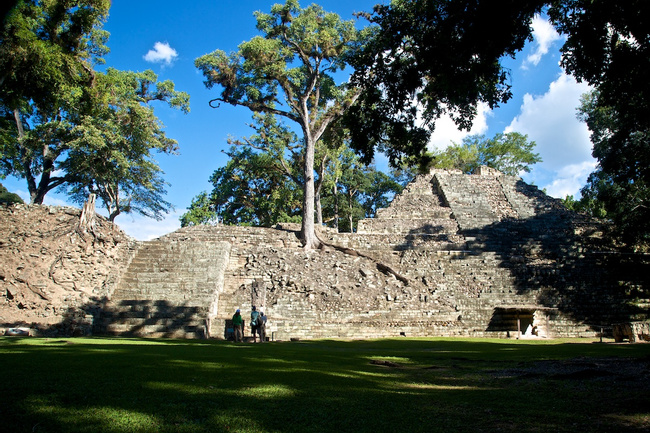
Copan Ruins
Set just across the border in Honduras, the Mayan site of Copán features some of the best ruins in the Mayan world. The hieroglyphic carvings here are magnificent, as are the well-restored pyramids, palaces, and stelae. The artistry at Copán is exquisite and without parallel.
More about Copan Ruins
Mayans likely settled the Copán Valley in 100 AD, although recorded history at the site of Copán does not begin until 426 AD. The early rulers of Copán were part of a dynastic line established by king Yax K’uk’ Mo. Copán began its rise to power in 553 AD with the ascension of Moon Jaguar as king, who is credited with building the Rosalila Temple. The next great ruler, Smoke Imix, established Copán as a regional military and commercial power; he also built a prolific number of monuments. His successor, 18 rabbit, was another productive builder and military conqueror.
In the 8th century, king Smoke Shell commissioned Copán’s incredible Hieroglyphic Stairway, which includes 2,500 glyphs that record the city’s past. Around this time, however, the city was in decline, and Copán’s final ruler took the throne in 822 AD. Some historians believe that Copán had a sudden rather than gradual collapse. The collapse was possibly the result of environment degradation due to population explosion—at its peak the city may have held around 25,000 people. Drought, soil erosion, and deforestation likely contributed to the collapse of Copán.
In the Great Plaza, you’ll find a variety of stelae, many of which date back to the 7th century. South of the Great Plaza is the Hieroglyphic Stairway, which contains 2,500 glyphs on 72 steps—it is the longest known Mayan hieroglyphic inscription in the world. Commissioned in 753 AD, the stairway was initially found by archeologists as a collapsed mess. Archeologists are still working to get the steps in the correct order and decode the long message.
A tomb beneath the Hieroglyphic Stairway was discovered in 1989. Laden with pottery and jade objects, it is thought to belong to a royal scribe or one of the sons of Smoke Imix. Digging deeper, archeologists also unearthed an earlier temple and a chamber dedicated to Copán’s first king.
Copán’s most dominating feature is the Acropolis, which rises to a height of 100 feet (30 m). This was the ceremonial and political center of Copán. Rituals and sacrifices were performed here, and rulers were entombed underground. Excavated tunnels, some of them open to the public, weave beneath the Acropolis to the Rosalila Temple.
Túnel Rosalila, one of the original excavation tunnels used by Copán’s first archeologists, can be explored. It leads to the Rosalila Temple. Although only a small portion of the tunnel is open to visitors, you can see some of the best-preserved stucco in the Mayan world here. A second tunnel, Túnel de los Jaguares, takes you to Tumba Galindo, a tomb that was discovered in 1834. It includes burial tombs and an impressive macaw mask.
In addition to these structures, Copán has an array of other Mayan artifacts, including stelae, ball courts, and monuments. It takes some time to walk around the site and really appreciate the depth of the ruins.
Copán’s large, two-story museum is fantastic. There is a full-scale replica of the red Rosalila Temple, which offers visitors an opportunity to witness the grandeur of what Mayan temples may have initially looked like. Also in the museum are original carved monuments, sculptures, altars, stelae, and original building facades.
Moments to look forward to
Friends Vacation Exploring Mayan Ruins
I think efforts are being made, and change can be slow. People are aware of the problems of pollution in the air and lake.
We believe travel is more than ticking destinations off a list – it’s about discovering new places deeply, feeling connected wherever you go, and knowing you have a trusted team behind you every step of the way.



